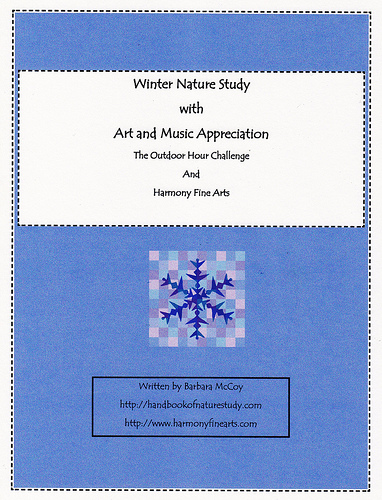Outdoor Hour Challenge
Winter Series Ebook
Winter Sky and Stars
Inside Preparation Work:
There is a section starting on page 823 on the Winter Stars. The clear explanations of the constellations in the Handbook of Nature Study make it an excellent first resource for families. For example: The lessons on page 820 explaining the North Star and the Big Dipper are clearly put down for anyone to follow and are timeless. The language used in the Handbook of Nature Study makes it enjoyable to read.
“After the polar constellations are learned, we are then ready for further study in the still earlier evenings of winter, when the clear atmosphere makes the stars seem more alive, more sparkling, and more beautiful than at any other period of the year.”
Handbook of Nature Study, page 823
“Orion is one of the most beautiful constellations in the heavens. It is especially marked by the three stars which form Orion’s belt, and the line of stars below the belt which form the sword.”
Handbook of Nature Study page 825
Read pages 823-829 in the Handbook of Nature Study. These pages outline a study of the winter stars along with some ideas for observations and activities.
Read pages 855-859 in the Handbook of Nature Study. This section on our moon is a delightful lesson showing some basic facts about the moon and its make-up. On page 858 there are 16 suggestions for observing the moon. If you purchased the Winter Nature Study ebook, you may wish to print out and take the Moon Observation Notebook Page so you can record your nightly moon observations this month. Otherwise, you can record your observations in your nature journal.
Additional Preparation Work:
Read chapter three in Discover Nature in Winter. Read the chapter with a view to picking some winter stars to learn about and observe as a family. Start with the North Star or Orion’s belt if you are not sure what you are doing yet. You can also choose to view the moon in the winter sky. Please note this link to Amazon is an affiliate link.
Page 37 give this advice, “Unlike owls and other nocturnal creatures, our eyes are not well designed for seeing in the dark. After leaving a lighted building at night, it takes about thirty minutes for our eyes to become adjusted to the lower light levels.” Allow plenty of time for your eyes to adjust and to take in the night sky.
Our family decided to make sure we can find these four constellations in the winter sky:
- Big Dipper (North Star as well) page 44
- Ursa Major page 45
- Cassiopeia page 47
- Orion (using Orion’s belt) page 49
Outdoor Hour Time:
Use your outdoor time this week or any week this month to observe the stars and moon. Our family bundles up with blankets to observe the winter sky. We use our binoculars to observe the moon especially when it is full or near to being full.
If you can’t fit in some night time star gazing, how about some sunset observations? Being able to name a star or constellation is a great skill but it can be just as satisfying to spend some time contemplating the universe while gazing up at the winter sky.
Follow-Up Activities:
Follow up with the notebook pages (Winter Sky and Moon Observations) in my Winter Nature Study ebook or with any of the general notebook page from my Freebies Page. You can also record your observations and thoughts in a blank journal of your choice. Star gazing is something you can do at any time of the year and we try to make it a habit in our family to observe the moon as it makes its full cycle.





I’m so glad you posted this challenge! We are studying astronomy this year, but I admit we haven’t done much but read in a textbook. This will get us motivated to go outside and look at the real stuff. I love the winter night’s sky!!
This is a wonderful blog! I think I am going to make you a permanent part of my homeschool! So…when would you like to move your family into our spare room?
Actually, is there a way to subscribe by email?
Hi Christy!
Thanks for the comment…there is a place to subscribe on my right sidebar. Glad you are going to join us.
Casey,
Stay motivated and get outside a few times. It is a blast. Cocoa and cookies are obligatory afterwards!
Barb
We really enjoyed doing this challenge, and the kids have asked to do it more. They even wanted to get a tent and stay out there, lol! Thanks for an inspiring activity.
I’m looking forward to jumping into these challenges!
We are loving astronomy and enjoyed putting together a post for the challenge.
Even after taking a high school astronomy course, I learned something new about Polaris, the Big Dipper, and the Little Dipper. Hoping for some clear nights so we can find these constellations again now that we have some new information about them.
Learned about Cassiopeia and Orion; and saw both constellations clearly in December. This was the first time I’ve ever seen Cassiopeia…and it was actually Olivia (who is 8 years old) who pointed it out to me! Using The Handbook of Nature Study and your website is definitely making a huge impact on our lives!